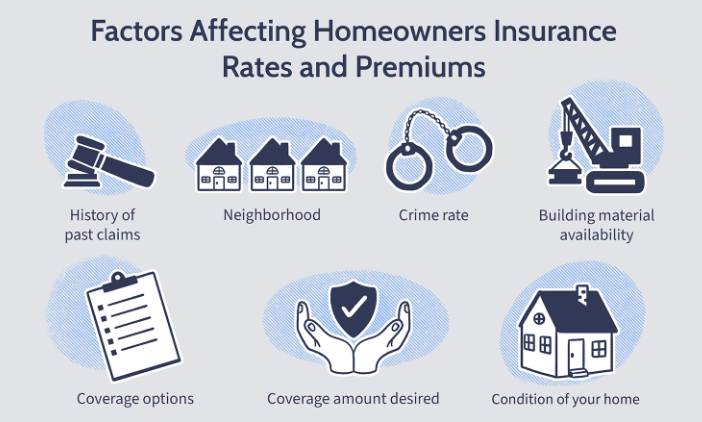Home insurance is one of the most important investments a homeowner can make. It protects your property, possessions, and liability against unforeseen events like fire, theft, natural disasters, and accidents. But when purchasing home insurance, one of the most crucial aspects to understand is how to select the right coverage limits. Coverage limits determine the maximum amount your insurance policy will pay out in the event of a claim. Setting these limits too high or too low can either result in overpaying for unnecessary coverage or leaving you financially vulnerable in the event of a disaster. This article will guide you through the factors you should consider to choose the right coverage limits for your home insurance.
What Are Coverage Limits?
Coverage limits refer to the maximum amount an insurance policy will pay for a covered loss. In the context of home insurance, the main coverage limits are for the dwelling, personal property, liability, and additional living expenses.
- Dwelling Coverage Limit: This covers the cost to repair or rebuild your home if it’s damaged or destroyed by a covered peril such as fire, vandalism, or a storm.
- Personal Property Coverage Limit: This protects the belongings inside your home, such as furniture, clothing, electronics, and appliances, against loss or damage.
- Liability Coverage Limit: This covers legal and medical expenses if someone is injured on your property and sues you for damages.
- Additional Living Expenses (ALE) Limit: This covers the costs of living elsewhere if your home is uninhabitable due to a covered event.
Step 1: Assess the Value of Your Home
The first and most important step in choosing coverage limits is assessing the value of your home. Many homeowners mistakenly choose a coverage limit based on the market value of their home. However, the insurance coverage limit should be based on the replacement cost of your home, not its market value.
Replacement cost is the amount of money required to rebuild or repair your home with materials of similar kind and quality, while market value includes factors like land value and current market conditions.
For example, if your home is worth $400,000 on the market, but it would cost $350,000 to rebuild, your coverage limit should be around $350,000. A good way to determine your home’s replacement cost is to consult a professional appraiser or use online calculators offered by insurance providers.
Step 2: Understand Your Personal Property Value
Personal property coverage protects your belongings, which can include everything from clothing to electronics to furniture. To choose the right coverage limit, take a home inventory, which involves making a detailed list of your possessions along with their approximate values. Some people underestimate the value of their belongings, which could result in inadequate coverage.
A home inventory should be comprehensive and include photographs or videos of items, along with receipts or estimates for major purchases. Many insurance companies offer mobile apps or websites that help you track your belongings over time, making it easier to update your inventory.
You should consider adding a personal property endorsement or rider if you have high-value items like expensive jewelry, collectibles, or artwork. These items often have limited coverage under a standard policy, and a rider can provide additional protection.
Step 3: Factor in Liability Coverage
Liability coverage is essential if someone is injured on your property or if you or a member of your household accidentally causes damage to someone else’s property. In lawsuits or accidents, the costs of legal defense, settlements, and medical bills can quickly exceed basic liability limits.
Most standard home insurance policies offer liability coverage between $100,000 and $300,000, but it’s often a good idea to increase this coverage limit if you have significant assets or if your home sees a lot of visitors (e.g., if you regularly host parties). Higher liability limits can protect your personal assets from being seized to pay legal costs or damages.
Consider increasing your liability coverage to at least $500,000 or even $1 million, especially if you own multiple properties, have a swimming pool, or engage in high-risk activities on your property.
Step 4: Don’t Forget About Additional Living Expenses (ALE)
Additional Living Expenses (ALE) coverage provides funds to cover the cost of living somewhere else if your home is rendered uninhabitable by a covered loss. This includes hotel bills, meals, and other expenses incurred while your home is being repaired or rebuilt.
ALE limits are often a percentage of your dwelling coverage limit, typically 20% to 30%. However, you may want to adjust this based on your specific needs. For instance, if you live in an area with high rental costs, you may want to increase your ALE coverage to ensure you can comfortably cover your living expenses during repairs.
Step 5: Review Your Policy’s Deductibles
The deductible is the amount you must pay out of pocket before your insurance coverage kicks in. Policies with lower deductibles usually have higher premiums, while policies with higher deductibles often come with lower premiums.
When choosing coverage limits, take into account the deductible amount. If you choose a higher deductible to save on premiums, ensure that you can afford to pay the deductible if you need to make a claim. Conversely, if you have a lower deductible, your premium may be higher, but you won’t have to pay as much out of pocket in the event of a loss.
Step 6: Account for Local Risks and Natural Disasters
Your geographic location plays a significant role in determining your home insurance needs. If you live in an area prone to certain natural disasters, such as floods, earthquakes, or hurricanes, you may need additional coverage beyond the standard home insurance policy.
In some cases, you may need to purchase separate policies for specific risks. For example, a standard home insurance policy doesn’t typically cover flood damage, so you’ll need to purchase flood insurance if you live in a flood-prone area. Similarly, you might need earthquake insurance if you live in a seismic zone.
Step 7: Regularly Review Your Coverage
Home insurance needs can change over time. You may make renovations to your home, acquire more expensive personal property, or experience a change in family circumstances that affects liability coverage. That’s why it’s important to review your coverage limits annually or after significant life events. This will ensure that you’re adequately protected and that you’re not overpaying for unnecessary coverage.
Conclusion
Choosing the right coverage limits for your home insurance is about balancing adequate protection with affordability. By assessing the replacement cost of your home, evaluating the value of your personal property, considering your liability exposure, factoring in additional living expenses, and reviewing your risks, you can determine the right coverage limits for your needs. Regularly reassess your coverage limits to ensure that you remain adequately protected as your circumstances evolve. By understanding your options and taking the time to make informed decisions, you can ensure that your home insurance provides the protection you need when the unexpected occurs.







